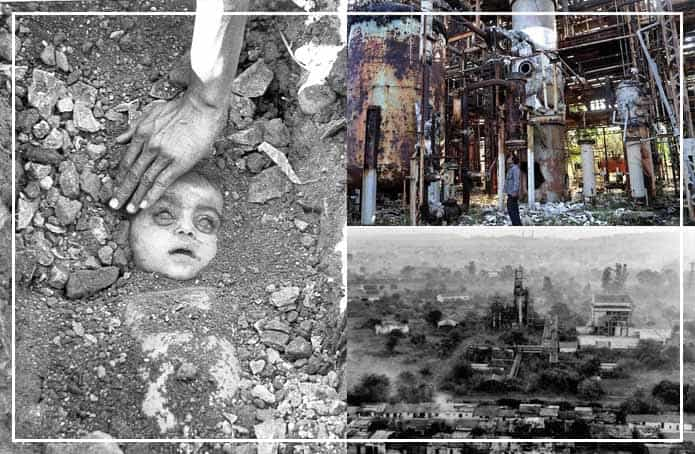Bhopal gas tragedy was one of the world’s worst gas industrial disasters that occurred on the prevailing night of December 2-3 in 1984, it had claimed several innocent lives and those who were left alive had serious health complications.
According to official records, the disastrous tragedy took 3,787 innocent lives. Initially, it was estimated to be 2,259 but was later updated by the Madhya Pradesh government. According to an official declaration submitted in 2006, the government said that the Bhopal gas tragedy caused 4,58,125 injuries that included 38,478 temporary partial injuries and around 3,900 severely and permanently disabling injuries.
Around midnight on 2nd December 1984, the chemical reaction started in the Union Carbide India Limited (UCIL) pesticide plant in Bhopal, Madhya Pradesh. More than 5 lakhs people were exposed to methyl isocyanate (MIC) gas after the toxic gas started to leak from one of the tanks in the factory. The whole city in no time turned into a gas chamber.
❍ Health Toxic Methyl isocyanate Gas
Methyl Isocyanate (MIC) is a chemical that is used in the manufacture of polyurethane foam, pesticides, and plastics. It is handled in liquid form which can be easily burned and is explosive. It evaporates quickly in the air and has a strong odor. Its molecular formula is CH3NCO or C2H3NO and its molecular weight is approx. 57.05 g/mol. It is used in the production of pesticides, polyurethane foam, and plastics.
❍ Health Toxic Gas Plant in Bhopal
The UCIL gas plant in Bhopal had three underground 68,000-liters liquid MIC storage tanks. On a disastrous night the gas leak in the Union Carbide, also known as Dow Chemical, started at the Plant Number C. The use of methyl isocyanate gas was to cool the plant after mixing with water. During this, there occurred tremendous pressure in the tank and it began to release tonnes of the toxic MIC gas leak from tank E610.
This leaked poisonous gas immediately started spreading in the Bhopal city from the UICL plant, which killed people – both awake and asleep.
It is approximated that about 40 tonnes of methyl isocyanate (MIC) gas escaped from the tank into the atmosphere within two hours.
As a chemical methyl isocyanate is extremely toxic and if its concentration in the air reaches to 21ppm (parts per million), it could not be tolerated and can result in pulmonary or lung edema, emphysema and hemorrhages, bronchial pneumonia and death. In the Bhopal tragedy, the level was much higher than 21ppm.
❍ Health Consequences in Bhopal after the Leakage of MIC
The consequences of the poisonous gas were a menace to the city. It started to spread largely into the city of Bhopal,
- A large number of the city’s population was coughing, complaining of itching in eyes, skin and facing problems in breathing.
- The gas caused internal hemorrhage, pneumonia, and death.
- The worst affected were the people residing in the villages and slums within the proximity of the gas plant.
❍ Harmful Effect on Health Passed As a Legacy since 35 years
The harshness of the situation intensified because the alarm system in the UCIL did not work for several hours. A large number of people started to rush to the hospitals on the morning of December 3, 1984, complaining of several health ailments.
People complained of breathing disorder, itchiness in eyes, rashes, skin irritation, dizziness, sudden blindness among others and were clueless about all facing similar problems. Even doctors were baffled and clueless with so many people coming with similar ailments.
Internal organs such as lungs, brain, eyes, muscles, gastrointestinal, neurological, reproductive and immune systems of those exposed to the toxic gas in Bhopal were severely affected. Bodies of people and animals were lying unattended on the streets. Plants in the city turned black with the intense toxin in the air. Many pregnant women‘s fetuses were damaged due to the toxic air in the city. The fertility of men and women was also affected.
With the miscarriage, the growing fetus was damaged and affected fertility in men and women. After a long time of the disaster, traces of several toxins were found in the breast milk of mothers and were transmitted to the babies. People won’t be able to work due to which the economy suffered. People were left with no money and were not able to fulfill their basic necessities.
❍ Who Was Responsible For This Tragedy
Warren Anderson was the company’s chairman. After four days of a deadly gas leak at Union Carbide’s plant in Bhopal, consequences of which led to the killing of thousands in 1984, the company’s chairman, Warren Anderson, was arrested on his arrival in the capital of Madhya Pradesh. Later, after under house arrest for only a few hours, Anderson was given bail and he immediately absconded the country and never returned thereafter.
“For Working with Toxic Substances One Should Be Extra Careful and Vigilant” Otherwise Through Generations One Has To Suffer”
❖ Read More:
➥ Control of Diabetes by a Natural Lifestyle
➥ Stones in Gallbladder: Know the Facts
➥ Healthy and Glowing Skin with Yoga Asanas
➥ Activated Charcoal Turning a Boon for Keeping Good Health
➥ Nutritional Requirements for High Blood Pressure Treatment

























